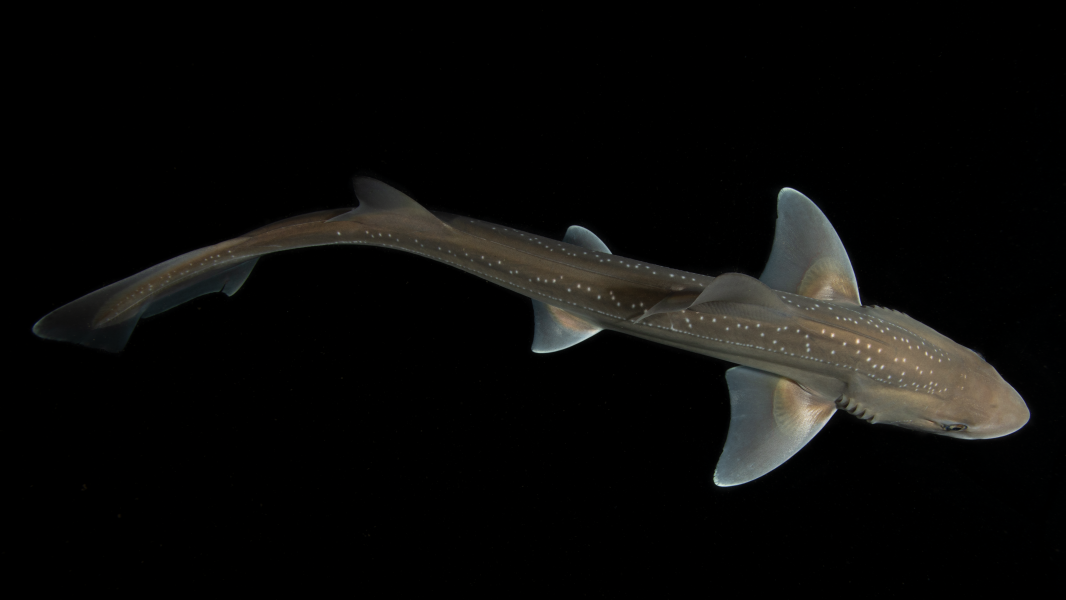Sharks have long been thought to be silent creatures, relying on their stealth to hunt prey and avoid predators. But now, for the first time, shark sounds have been recorded.
New recordings show that whitetip reef sharks (Mustelus lenticulatus) — small bottom-dwelling sharks native to New Zealand — make distinct clicking sounds when researchers handle them underwater. The sounds were consistent and repeated across multiple individuals, and may be related to a stress response or defensive behavior, according to the authors of the study, published March 26 in the journal Royal Society Open Science.
The recordings represent the first known instance of a shark actively producing sound. “Sharks have sensory systems that are more advanced than hearing, including electroreceptors, olfaction, and the way they move through the water,” lead author Carolyn Nieder, a research scientist at the Woods Hole Oceanographic Institution, told Live Science. “But I think the traditional idea that sound isn’t important is also unlikely to be true.”
Ten young reef sharks were accidentally discovered making sounds during routine behavioural experiments at the Leigh Marine Laboratory at the University of Auckland. When the researchers briefly held them underwater, all 10 sharks produced audible clicks.
The clicks were particularly loud early in the experiments, but then tapered off as they continued, Nieder said. “They may not have been in fear for their lives,” she added, pointing out that in the wild, loud clicks can distract young sharks for a moment, helping them escape when being pursued by predators.
Most sharks are considered silent because they lack swim bladders, the air-filled sacs that fish typically use to make sounds. Micro CT scans and 3D reconstructions of reef sharks have also found no obvious organs or structures capable of producing sound.

Scientists noticed the clicking sounds after handling the sharks during routine behavioral experiments.
The team suggested that the sounds could be related to the clicking of shark teeth.
Reef sharks have broad, blunt teeth arranged in tightly packed plate-like formations that are perfect for crushing hard-shelled prey like crabs. Researchers say this “sidewalk dentition” may have a secondary function: creating a sound when the jaws snap shut.
However, Nieder noted that without direct observation of the sharks' jaw movements when they snap, this mechanism remains speculative.
Each click lasted about 48 milliseconds and sometimes exceeded 155 decibels, comparable to a shotgun blast.
About three-quarters of the clicks were single clicks, the rest were short double clicks. The scientists noticed that about 70% of these clicks occurred during a state of calm, swaying body movement, but some occurred without any visible movement.
It is not yet known whether the clicking is an accidental side effect of interacting with the device or whether it is intentional behavior.
The frequency range of shark hearing is mostly below 1 kilohertz, which is significantly lower than the frequencies of their clicks, so it is unlikely that the clicks are intended to communicate with other sharks.
However, some well-known reef shark predators, such as New Zealand fur seals (Arctocephalus forsteri), are sensitive to higher frequencies and may become startled or confused by sharp clicks.
A number of species of rays and skates, close relatives of sharks, are also known to make clicking sounds when disturbed by divers. These sounds are thought to serve as warning signals or distress signals.
Nieder said future research could focus on closely related shark species to see if they, too, can make sounds and if they do so in response to
Sourse: www.livescience.com





